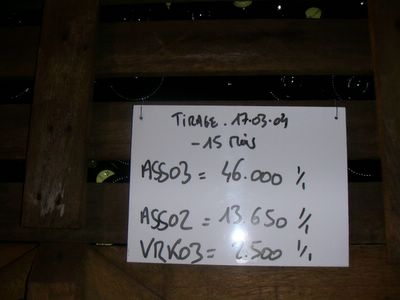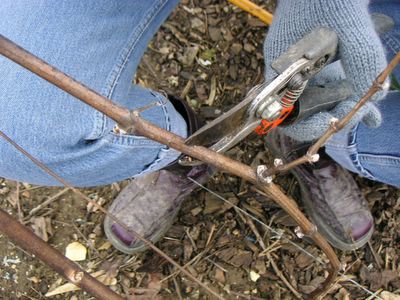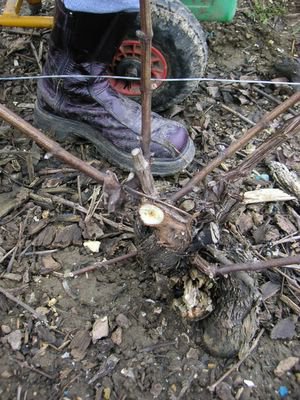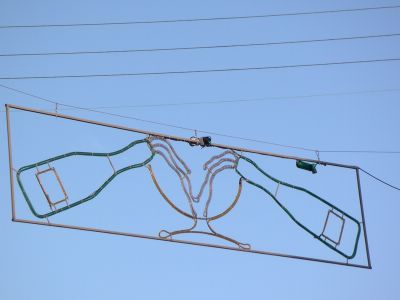 This pruning shears can handle most branches if you hold it correctly... and that, dear reader, is not like this!
This pruning shears can handle most branches if you hold it correctly... and that, dear reader, is not like this!The first day in the course on how to prune the vine is over. We are 25 in the group, and our young teacher has spent a great deal of the day to explain - in rather many details - how the final exam will pass off. On top of that the little slips you may fall into, big enough however to send you right out of the game. She sure knows how to motivate.
We are familiar with the dates as well. On March 31st and April lst, in the village of Bisseul, that houses schoolvines as well, we can get the abilities, we are supposed to gain today and the following nine thursdays, tested by a
grand jury of three, profesionnels such as teachers,
vignerons and staff from the CIVC (Comité Interprofessionnel du Vin de Champagne).
A useful paperOf course it is not at all necessary to do the test, but why not, urges our
prof. The paper is recognized in the area as what you need to work in the vineyards.
And you sure need paper to work there. A guy from the group explains, that he already tried to look for jobs in the vineyards. Even proposed to work for free in order to obtain the experience and knowledge he lacks. Nobody was interested. Since it takes one man to educate another, and why would you educate a stranger for free?
 Vines pruned the Chablis-way with old charpentes.
Vines pruned the Chablis-way with old charpentes.So now he is in school with the rest of us, who are here for different reasons: Unemployment, necessary education before you join the family business and
vignerons like Alain, who are here to pick up one or two details.
There is no public presentation of names and background. My ears are almost popping out of my head to try to catchr what each and everyone whispers. Not easy. I will have to do the talking once we are in the vineyards. That is if I have time for it. The pracical part of the pruning does not come easily to me.
Chablis and Cordon de RoyatDuring this and the next 10 thursdays we will be taught two methods of pruning. Both are accepted all over Champagne no matter the classifications of the grapes (grand cru, premier cru, autres crus):
Chablis and
Cordon de Royat, both usable for all grape varieties.
Further two ways of pruning exist:
Vallée de la Marne, which is only allowed for non-classified Meunier like ours, and
Guyot, which is allowed for non classified grapes of all types (Chardonnay, Pinot Noir and Meunier).
The pruning of the vines has several objectives:
To get a good balance between the surface of the leaves, the amount of grapes and the amount of wood.
To help the grapes mature and secure their quality and amount.
To give the vine a certain shape to facilitate the works with the tractors and also make the pesticides work more efficiently.
Pruning makes a vine live longer, you prevent it from wearing itself down.
You strengthen the plant when you remove branches that are not fertile in order not to waste the precious sap in too many branches that do not grow grapes anyway.

A Chablis-pruned Chardonnay-vine. Charpentes and lancement can be seen, the rachet must be around as well.
Rachet, lancement and charpente
We begin with the Chablis-method - our teacher, Stéphanie - finds it the most complicated and thinks we might as well get it over and done with.
She is a fresh outdoor girl, it seems. Wearing two fleecejackets and red chins but neither bonnet nor gloves even the wind is a cold one straight North, she squats with her pruning scissors to demonstrate the secrets of the Chablis. She works methodically, already a big change for me who compare with Alains preferred way of attacking everywhere at the same time. So it seems to me anyway. This is much more appropriate for learning:
First we must choose the little one - the technical term is the rachet - this is the rejuvenation of the plant, and the most important part of the pruning. First of all you choose a beau bois from the bottom of the plant to use. Then you cut in a heigth of two buds. From these two new shoots will grow, and they will produce grapes next year if they develop well.
Next thing to deal with is the long branch, which has grown since last year. It is called the lancement, and will probably grow into a new charpente, that is if it develops nicely. It is placed in a vertical position and cut so just one bud is left on top of the upper wire. This branch has the second priority after the rachet in case you have to choose.
Finally we must clean up the three old charpentes and last years lancement, which now will be promoted to a charpente if it is strong and vigorous enough. You begin cleaning in the right corner and work your way leftwards. In this way the younger one is normally dealt with as the first. A healthy shoot is chosen on the one year old part of the charpente - this is the prolongement - and it is pruned one bud on top of the second row of thread just like the lancement. All other branches are removed. The second charpente is dealt with similarly. We just have to make sure that there is at least 30 centimetres between the two prolongements. On top of that the shoots that will come from the buds of the two prolongements must not bother each other in any way. We check how the vine will be attached in order to secure ourselves against this phenomenon. Strictly forbidden it is, and worse, you fail your exam if you do this, says Stéphanie). It is called superposition.
The oldest of the charpentes is twisted out of the bindings and forced towards the first thread - it is covered by bark that is several years old and it is hard and almost unbendable as a trunk. What is possible? Are there any good shoots from last year? Is there still enough room for all charpentes and prolongements? If they bother each other, we remove one - often but not always the oldest one. Two charpentes with two prolongements are enough to ensure enough grapes.
We must watch out for especially two specific things:
- One - superposition - is when a shoot from last year is crossing another even it is above or under.
- The other - chevauchement - is when the branches of one vine grows into the space of the next plant on the row. A charpente with a prolongement this long will have to be removed as well.

It is important to prune as close to the stem as you can to avoid growth that you do not want.
The art of holding the secateur right
To learn to prune a vine really means that you learn to use the theory in the way that suits your plant the best. Very few vines actually have excactly the branches that you need to meet the demands of theory completely. We must learn how to balance our choices in a good way.
One thing is to handle the secateur correctly. This means, that we hold the mobile part of the tool - which is the left for a righthander like me - with four fingers and the thumb around the right part. The broad part of the scissors is supposed to meet the part of the wood that will remain after the pruning. The last thing to remember is that you place the branch to cut as far into the open scissors as you can. If you at the same time pull the branch to be removed towards yourself while you cut, you can actually remove even quite thick branches with an ordinary secateur.
It is a trick that is quite necessary for me, since I do not have the strength in my hands that is otherwise important if you do not have the big scissors. Which we will not at the exams.
On top of holding the scissors and place them correctly, we must learn to cut with an angle. An angle that slides down from the side of the bud. In this way the tall end is on top of the bud, and in this way sap running from within the plant will never in case of frost be of any damage to the bud itself.
I already plan to do some homework next weekend in my mother-in-laws rows of Chablis-pruned Chardonnay-grapes.
Test in three stages
It is the winegrowers themselves that control the final test. The diploma works as your way of being recogniced as a skilled worker. You cannot let anyone fool around with the future yield in your vineyards. The test consists of a written, practical and oral part. Each test you fail will send you straight out of the rest of the tests.
During the written test you have 10 minutes to answer at least seven of 10 questions correct.
If you manage this, you move on to the practical part. Each candidate must demonstrate either how to prune two Chablis-vines or two Cordon de Royat-vines and attach them as well. You get eight minutes to do you thinking and your pruning. Afterwards you must bind the vines, but that is not on time. If your three censors think that you have managed the pruning in a satisfactory way, you move on to the last part of the test.
It is oral. You choose a piece of paper with a question, get around 10 minutes to prepare your answer, and are finally asked questions about it in the same amount of time.
And that is all... the people who make it through all three tests, will get their diploma as they want it: in the school, send by mail or at the local Saint Vincent party in mid January.
After the first thursday in the course I note that:
1. I can follow what happens in the class quite well,
2. I do not understand much of the theory told in the vinyard. I just do not have the mental surplus to listen and work at the same time,
3. I - as always - hold the tools wrong. 31 years after my desperate teacher tried to teach me how to hold my pencil correctly I still handle it the wrong way... but I do write anyway.
My goal is still to get the diploma to be the first Dane in Verzy to get the pruning certificate during Saint Vincent. Should you want to cross your fingers for me, I shall be happy to receive any support.
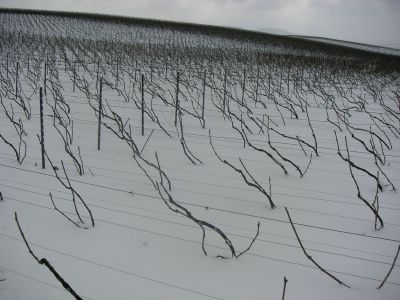
Even well buried in the snow of 2005 you can still see that these Chablis-pruned Chardonnay have only two charpentes.
På dansk
Copyright: The copyright for text and photos at bobler.blogspot.com belongs to Solveig Tange. You may use my articles, photos or parts of them for non-commercial use and if I am credited as the author. Feel free to link to this site but not in your own frameset please.







